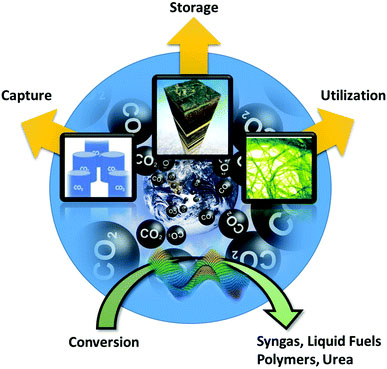| May 18, 2022 |
Electrocatalytic CO2 reduction: role of the cross-talk at nano-carbon interfaces
(Nanowerk News) Inspired by Nature, conversion of CO2 into added-value chemicals needs complex synthetic machinery, regulated by confinement of reagents, task-separation, orchestration of rates and functions by making extensive use of specialized bio-interfaces.
|
|
The expectation for the next generation of electrocatalysts is to rival the natural asset, through a creative design of functional interfaces and new contributions across scientific disciplines.
|
|
The broader vision is to merge materials science and tailored electrocatalytic interfaces with biological routines. Taking the best of the two worlds, by coupling artificial electrocatalytic CO2 reduction reaction (CO2RR) with biological CO2 fixation.
|
 |
| CO2 mitigation approaches highlighting the conversion of CO2 into valuable carbon-containing products, via chemical fixation through reaction pathways carved on tailored potential energy surfaces. (Image: European Research Institute of Catalysis)
|
|
The electrocatalytic CO2 reduction reaction (CO2RR) is an interfacial process, involving a minimum of three phases at the contact point of gaseous CO2 with the electrodic surface and the liquid electrolyte. As a consequence, surface chemistry at composite interfaces plays a central role for CO2RR selectivity and catalysis.
|
|
Each interface defines a functional boundary, where active sites are exposed to a unique environment, with respect to distal sites in the bulk of organic and inorganic domains. While the individual role of each component-type is hardly predictable “a-solo”, the interface ensemble worksviaa strategic interplay of individual effects, including: (i) enhanced electrical conductivity, (ii) high surface area and exposure of the interfacial catalytic sites, (iii) favorable diffusion and feeding of reactants, (iv) complementary interactions for the “on/off” stabilization of cascade intermediates, (v) a secondary sphere assistance to lower the activation energy of bottleneck steps, (vi) a reinforced robustness and long-term operation stability.
|
|
Selected CO2RR case studies are compared and contrasted to highlight how the organic domains of carbon nanostructures merge with metal and metal-oxide active sites to separate tasks but also to turn them into a cooperative asset of mutual interactions, thus going beyond the classic “Divide et Impera” rule.
|
Reference
|
|
Energy and Environmental Science "Electrocatalytic CO2 reduction: role of the cross-talk at nano-carbon interfaces"
|
About DECADE Project
|
|
The DECADE project proposes a new photoelectrocatalytic (PEC) approach for the conversion of CO2 avoiding water oxidation as an anodic reaction to overcome the current limits in the PEC system and to maximize effective energy utilization.
|
|
The projectpartnership has a strong industrial character but comprises top-level scientists in the area and international collaboration with Japan to allow the best possible benchmarking for the novel approach developed.
|

